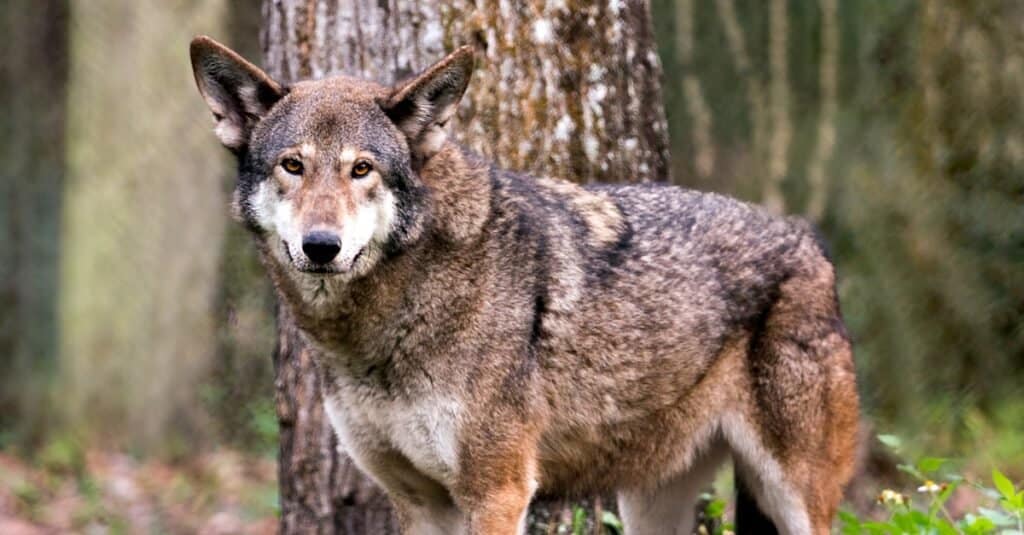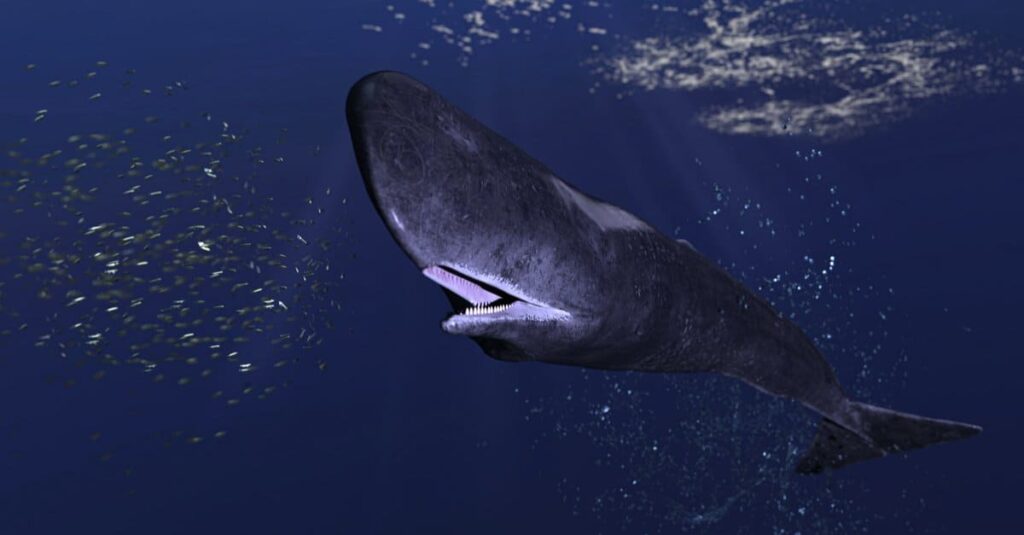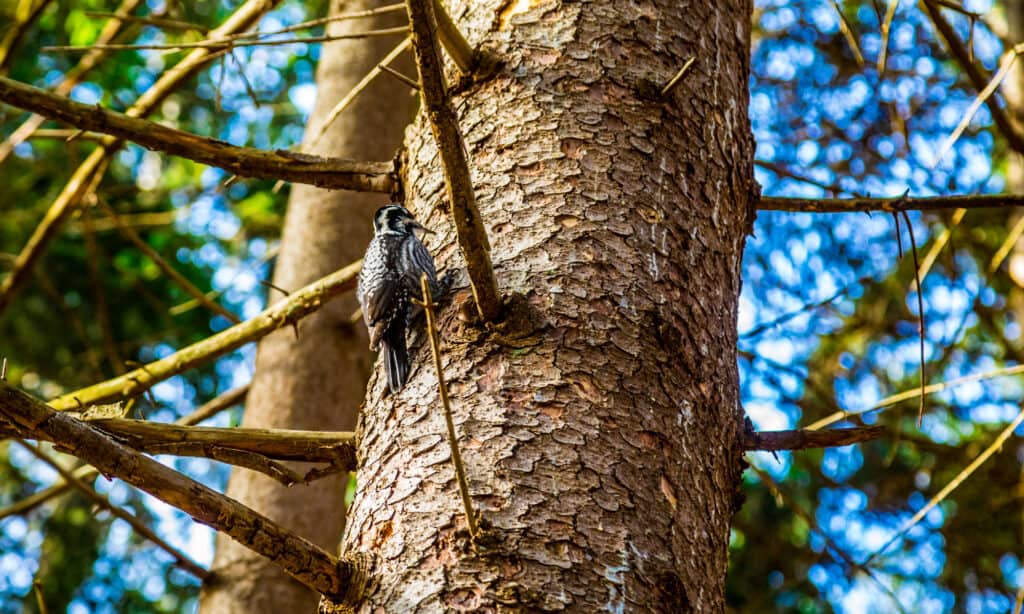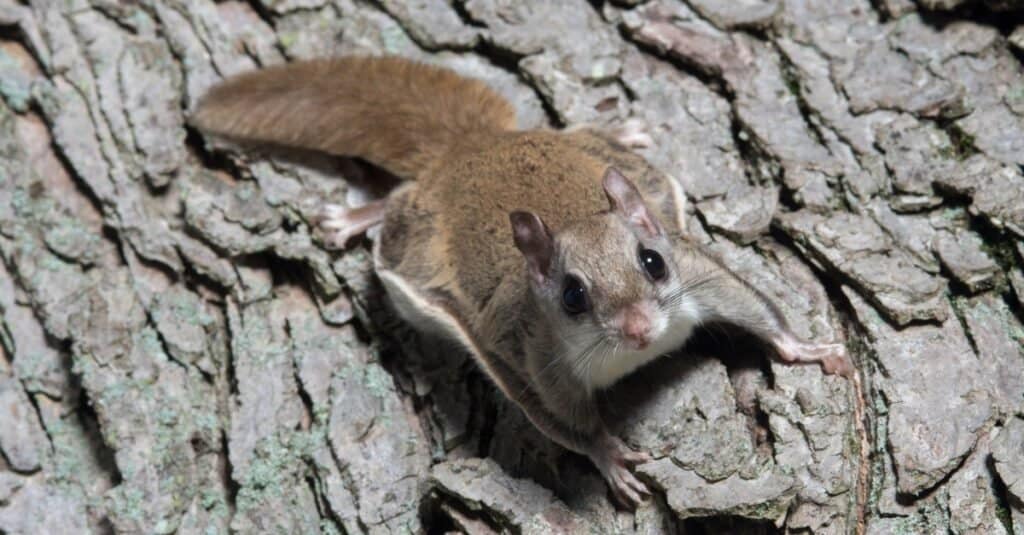We are in the middle of a major extinction. All around us, several animal species are disappearing thanks to pollution, habitat destruction, global warming, and other man-made events. The protection of all animal species is a collective human effort. Of course, you cannot be everywhere, and this is why you should start by being aware of endangered animals in your immediate locality and how to protect them. If you live in North Carolina, this article lists some of the endangered animals in the state.
1. Red Wolf

The red wolf is critically endangered, according to the IUCN Red List.
©Rejean Bedard/Shutterstock.com
The red wolf lives in the eastern part of North Carolina, in a region known as the Albemarle Peninsula. Over the years, this animal has witnessed a consistent depletion and is now dangerously close to total extinction. As of the time of this writing, there aren’t more than 14 to 17 of these animals left in the wild. Currently, the red wolf is the most endangered wolf species in the US and the world at large.
One reason the conservation of this species is important is that contrary to widespread belief, the red wolf does not attack humans. Their diet is mainly nutria — a large herbivorous rodent that decimates plants. They are also apex predators who keep coyotes out of their territories. To protect them, US Fish and Wildlife Service has rounded up these wolves outside North Carolina. In February 2022, it was revealed that there are now 223 red wolves living at conservations outside North Carolina. The plan is to repopulate the wild with them eventually. Currently, the US Fish and Wildlife Conservation puts radio tracking collars on them to keep tabs on their numbers to distinguish them from coyotes.
The red wolf has an interesting history. In 1980, the US Fish & Wildlife Service rounded up the last 17 purebred red wolves in the state. They were then declared extinct to the general public. Fourteen of those wolves were kept in a new national breeding program. Seven years later, the wildlife service reintroduced the wolves into the wild and discontinued the program. Their population at the time had climbed as high as 120.
Human activities, coupled with their slow reproductive abilities, have contributed greatly to their depletion in recent times. However, there is renewed hope for the species, as a new breeding program has been kickstarted to help them recover.
2. The Sperm Whale

Human activities played a major role in the endangered status of the sperm whale.
©bekirevren/Shutterstock.com
Sperm whales are some of the most fascinating aquatic creatures, but they’re also one of the endangered animals in North Carolina. They are believed to be the inspiration for the acclaimed fictional tale — Moby Dick. Commercial whaling played a huge role in the depletion of this large-toothed 15-ton animal. Ordinarily, the lifespan of a sperm whale is up to 60 years. But human activities such as fishing or being hit repeatedly by boats have considerably shortened their lifespan and decimated their population.
Since they were among the primary targets of the now-defunct commercial whaling industry that existed since the 1800s, their numbers dissipated a lot. Noise pollution also affects their distinctive communication patterns across the ocean, and scientists are studying how they communicate in the hope of helping them recreate it. Beyond human activities, environmental occurrences like climate change also contribute to their disappearance.
When commercial whaling was still the norm, humans hunted sperm whales for their oil, blubber, and a fascinating substance known as ambergris. Ambergris is also known as “floating gold,” and only sperm whales produce the substance. When it hardens, it becomes a sort of scented rock valued at over 50,000 USD. This substance is an important ingredient in the fragrance industry.
Currently, because the sperm whale is listed in the official American endangered list, hunting the sperm whale for ambergris is illegal in the US. However, in foreign markets, especially in certain parts of Europe, ambergris remains incredibly valuable and sought after by international brands like Chanel, expanding the endangered status of the Whale outside the United States.
3. Red-Cockaded Woodpecker

Deforestation played a major role in the endangered status of red cockaded woodpecker.
©Bosko/Shutterstock.com
The main habitat of the red cockaded woodpecker is old longleaf pine trees. However, deforestation has affected this tree species. The timber industry in North Carolina cuts down these trees at quite an alarming rate. Currently, only a small percentage of such pine trees are left. The incessant destruction of its habitat has left the red-cockaded woodpecker quite vulnerable in the last 50 years.
While it has made several lists of endangered species, it is much closer to extinction in the modern world than ever before — unless the timber industry can find another alternative, of course. In the 1900s, the woodpecker was bountiful in the pine forests of the Southeastern US. They were widely spread out in states like Oklahoma, Texas, and Tennessee. Today, there are just about 15,000 of these birds living, which is just about one percent of their original population. Conservancies now exist to keep the remaining species of the woodpecker, enabling them to breed and increase their population. However, they are still in need of more support if they’ll ever make a full recovery.
4. North Carolina Flying Squirrel

Predation and habitat loss are responsible for the endangered status of North Carolina flying squirrels.
©iStock.com/EEI_Tony
Despite the name, this animal lives in other places apart from North Carolina, like Virginia and Tennessee. The flying squirrel has thrived since the ice age in cold mountainous regions. But it has now begun to witness a decline in population in North Carolina. Several species of this animal exist. So, it is crucial to understand that only Glaucomys sabrinus coloratus is at risk of extinction.
Sometimes the flying squirrel uses trees for suitable nesting. Habitat loss due to deforestation, as well as predation, has contributed to endangering this animal. The endangered species of flying squirrels have important ecological roles. They help to disperse fungi and lichen spores which are incredibly crucial to tree maintenance. Trees, as we all know, are profoundly important to the ecosystem and climate change.
Since this animal has lived in isolation for a long time, science’s yet to uncover so many things about its basic biology, behavioral traits, and relations with other animals. Currently, there isn’t sufficient data to answer many of the questions we have about the flying squirrel. However, it is evident that the government would have to do something about the timber industry’s enormous contribution to deforestation and ecological destruction that’s gradually driving this species to oblivion.
Conclusion
In addition to these four, there are several other endangered animals that call North Carolina home. In this state and many others, it is obvious humans are largely responsible for the decimation of many animal populations, including those on this list. From game hunting to habitat destruction, humans are actively and unconsciously contributing to the extinction of these endangered animals. While these activities might help accelerate industrialization, we risk losing these animals that are of tremendous importance to the ecosystem. Efforts are ongoing to improve the chances of survival for these species and ensure they’re no longer in danger of extinction.
Up Next
- The 10 Most Endangered Species On Earth – And How To Help
- 5 Animals that Could be Extinct By 2050
- 10 Amazing Turtles in North Carolina
- Meet 8 Endangered Animals That Call Ohio Home
The photo featured at the top of this post is © Animalgraphy/Shutterstock.com
Thank you for reading! Have some feedback for us? Contact the AZ Animals editorial team.






